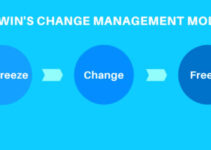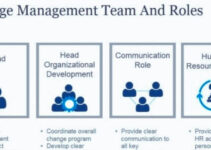The behaviors and attitudes of employees play a key role in their performance and contribution to the company’s growth and productivity. Experts and professionals employ various types of strategies and practices to improve some behaviors of employees that would amplify their productivity in the workplace. Today, we’ll discuss organizational behavior modification examples; the definition of OBM; steps involved in the OBM process; its benefits, challenges, and OBM examples.
What is Organizational Behavior Modification Theory?
Before jumping into the discussion of organizational behavior modification examples; it is significant to outline its definition. OBM is the personal management strategic approach that amplifies the measurable and observable behavior of employees in the workplace.
Tardiness and absence are some of the main examples of employee behaviors that need improvement; they also comprise quality and quantity of work. However, OBM focuses on encouraging and promoting desired behaviors and attitudes; discouraging undesired attitudes and behavior in the workplace.
Kreitner and Fred Luthana founded this strategic approach; OBM focuses on boosting morale and amplifying the effectiveness of employees in the workplace.
Process of Organizational Behavior Modification
Some of the main steps involved in the process of organizational behavior modification examples are as follows;
Recognizing Critical Behaviors
First of all, you should recognize the negative and unproductive behaviors and attitudes of employees in the workplace that are impacting their performance. Employees and team members exhibit various types of behaviors in the workplace; some of the critical behaviors are as follows;
- Following certain procedures and avoiding the rest
- Constructive criticism and complaints
- Speed or tardiness
- Presence and absence
It comprises recognizing the critical behaviors of concerned employees and team members and their managers and supervisors. You can follow the systematic approach to recognize such behaviors.
Measuring
After recognizing the negative behaviors, it is significant to measure the rate of frequency and occurrence. If the occurrence rate of behaviors falls within an acceptable range, then they don’t have to take any actions. However, if they increase the limit, then it requires management attention to change their behaviors.
Analysis
It comprises of in-depth analysis of existing behaviors and attitudes of employees to find out what types of behavior are causing the particular types of outcomes. The functional analysis allows you to determine and recognize the contingent outcomes. However, it also highlights many unpredictable events of organizational behaviors.
Intervention
Recognizing the critical behaviors and other relevant causing factors, helps you to develop a well-detailed strategic approach. The management should take intervention steps to change the negative behaviors. The objective is to reinforce the desired behavior and performance of employees. Companies could take various reinforcement strategies relevant to the situation and circumstances to receive the desired outcomes.
Evaluation
OBM is a systematic strategic approach and it tells you whether your intervention practices are working or not. The aim of OBM is toamplify performance and growth and change the negative behaviors of employees. You should compare the changed behavior with the baseline behaviors to make sure that you have achieved the positive changes. If your change isn’t suitable and relevant, then it requires you to implement some other strategic approach.
Benefits of Organization Behavior Modification
Some of the main benefits and strengths of organizational behavior modification examples are as follows;
Easy to Comprehend
OBM is a simple and easy strategic approach that managers and supervisors could easily comprehend its functionality. It has received significant attention in recent years; many businesses and companies are executing this strategic approach.
Analyzing & Comprehending Behaviors
OBM provides various tools and techniques to influence the behavior and attitude of employees. Employees and team members learn organizational behaviors and attitudes; managers and employees could change them with the right invention approach. Managers could alter the behaviors of employees with rewards and incentive systems.
Employees Growth
OBM offers you a lot of tools and techniques to upgrade the skills and behaviors of employees and change the negative behaviors. Positive reinforcement helps you to boost the morale and confidence level of employees. However, they conduct training programs for employees with this social learning theory.
Testing Employees
The focus of OBM is on the external exhibiting behaviors and attitudes of employees and helping managers and supervisors to take relevant and suitable steps. They can test the observable behaviors.
Challenges of Organization Behavior Modification
Some of the main challenges of organization behavior modification examples are as follows;
No Personal Autonomy
When managers and company leaders enforce certain types of behaviors and attitudes in the workplace; then it takes away the personal autonomy and freedom of a person as a human being and freely perform their roles and takes.
Jeopardizing Innovation & Creativity
When employees and team members behave in a certain way; then it jeopardizes their innovation and creativity. Many research studies have proven the fact that you would receive creative ideas when employees are freely thinking and performing their roles and tasks.
Avoiding Expectations & Beliefs
OBM follows the premise that you can control and manipulate human behaviors. Many modern studies have suggested that human behavior is the result of individual cognitive processes. It completely avoids the individual beliefs, needs, and expectations.
Old Concept
Many experts are of the view that OBM is in the disguise of a very old workplace philosophy. Managers and supervisors used to punish the negative results and admire the positive outcomes.
Bribery & Threat Approach
Many experts and professionals say that if you look at it, then positive reinforcement is nothing more than bribery for promoting good behaviors. Negative reinforcement works as a threat to the team members and employees.
Examples of Organizational Behavior Modification
Some of the main organizational behavior modification examples are as follows;
Incentives, Bonuses, & Wage Plan
In order to promote positive behavior in the workplace that improves the company’s culture, businesses and companies offer incentives, bonuses, and wage plans as positive reinforcement. It lets employees know that they are performing well within the required protocols of the company. Clear feedback plays a critical role in modifying and changing the behaviors of employees, it should be non-threatening.
Disciplinary Methods
Businesses and companies implement disciplinary measures and protocols as negative reinforcement to discourage and decrease unproductive and negative behavior. It could be in the form of job suspension, termination, or no bonuses. Such types of negative reinforcement compel them to change their unproductive and negative behavior.
Conclusion: Organizational Behavior Modification Examples |Organization Behavior Modification
After an in-depth study of the organizational behavior modification examples; we have realized that OBM is a highly effective strategic approach. If you are learning about organization behavior modification examples; then you should keep in mind the abovementioned definitions; processes, advantages, and disadvantages.
Ahsan is an accomplished researcher and has a deep insight in worldly life affairs. He goes Live 3 days a week on various social media platforms. Other than research writing, he’s a very interesting person.


